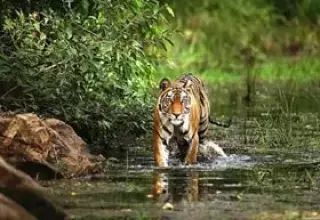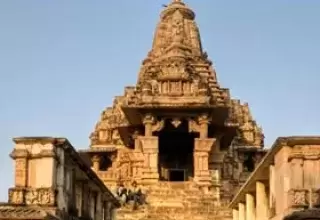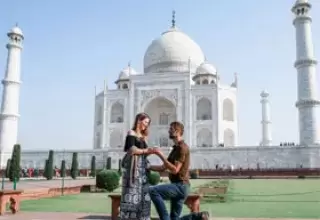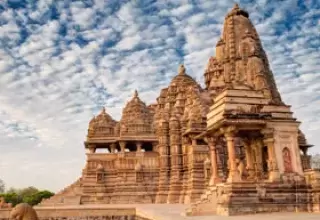Madhya Pradesh is known as the heart of the country, for it lies in the central part of India. Not only this, but it has another popular name as "The Tiger State of India" for the presence of majestic Royal Bengal Tigers. The state is a big epitome of rich cultural heritage, wildlife that wins hearts, and also the abundance of landscapes meeting the profound forest covers. As a whole, Madhya Pradesh is a perfect destination for all travel enthusiast who wants to discover versatility at one place! To make it to the place, there is a requisite of a grand tour package for Madhya Pradesh which is exclusively presented by Swan Tours.
Incredible Madhya Pradesh Tour Package
| Madhya Pradesh Tour Itinerary | No. of Days | Price* |
| Splendors of Madhya Pradesh | 04 Days / 03 Nights | Rs. 9, 950 |
| Madhya Pradesh Wildlife Tour | 05 Days / 04 Nights | Rs. 21,300 |
| Magnificent Madhya Pradesh | 06 Days / 05 Nights | Rs. 26, 500 |
| Best of Madhya Pradesh Tour | 07 Days / 06 Nights | Rs. 33,599 |
| Khajuraho Bandhavgarh Tour Package | 08 Days / 07 Nights | Rs. 39, 650 |
What Makes Madhya Pradesh a Perfect Holiday Destination?
Prior to any other information, you must focus on why you should choose Madhya Pradesh as your current holiday getaway. There are multiple factors that increase the value of Madhya Pradesh as a Holiday getaway for families and honeymooners, who further pick a customized Madhya Pradesh Holiday package. Some of them have been enlisted below:
- Natural Landscape
- Rich Culture
- Spontaneous Climate
- Wonderful Wildlife
- The mighty Narmada River
- Vindhya and Satpura mountain ranges
- Classic Local Cuisine
- Exquisite art and architecture (Chitera, Pithora, Gond and other tribal arts)
- Traditional Chanderi Fabrics
- Technological Progress
Suitable Time to Visit Madhya Pradesh
Madhya Pradesh is fenced by several states like Maharashtra, Gujarat, Rajasthan, Chhattisgarh and Uttar Pradesh. With three main seasons swaying in a year, it is determined that the best time to visit Madhya Pradesh is during the winters from October to March when the clime remains cool, moderate and soothing.
What does the Madhya Pradesh Holiday Package Include?
When you trust and rely upon Swan Tours for your Madhya Pradesh Tourism Package, you will be filled with exotic ventures from the arrival to departure and everything that lies in between.
1. Things to do:
- Move out for a wildlife safari in some of the popular national parks like Panna National Park, Satpura National Park, Kanha National Park, Bandhavgarh National Park, and Pench National Park.
- Trekking to the Highest Satpura peak at an elevation of 4,430 ft. from where you can get breathtaking views of Madhya Pradesh across the waterfalls and water streams.
- Get the real essence of beauty in Madhya Pradesh on a sail at Bhedaghat and capture the beauty of the place and charm of nature.
- Add to your adrenaline rush by jumping onto the most amazing water sports at Hanuwantiya Tapu that s located in Indira Sagar Dam. Try to visit the place during the Jal Mahotsav to explore the best present!
- Treat yourself to the enthralling cable car ride over the Dhuandar falls, where you cater to the Marble Rock and lavishing falls can capture the perfect landscape.
- Get going for the Pandav Cave Exploration in Pachmarhi and educate yourself about the ruins of the historical Afghan architecture in Mandu.
2. Places to Discover:
- Orchha: It is a prominent destination in Madhya Pradesh, situated on the bank of Betwa, which offers its tourists with temples, forts, and cenotaphs. If you wish to admire Bundela’s artworks, then this is the most ideal place with painted murals and tile work.
- Khajuraho: This place is mostly spelled when Madhya Pradesh tourism comes into discussion. This place is popular for the stunning temples and exotic carvings that define its architectural skills.
- Gwalior: This historic city holds importance for its king, Surajesan. It holds beautiful monuments, temples, and palaces which adds to its admiration and voices its cultural significance.
- Ujjain: This part of Madhya Pradesh is popular for serving as the pilgrimage center for its tourists. From Mahakaleshwar temple to the Kumbh Mela, it witnesses numerous tourists every year.
- Jabalpur: This part of Madhya Pradesh is located on the shores of the Narmada river that is one of the most sought places of tourist attraction. It holds both historical and cultural emphasis right from the past!
3. Famous Food:
- Poha: Flattened rice, made with onions, green chilies, tomatoes and curry leaves.
- Daal Bafla: It is the influence of Rajasthani Cuisine, coming from the popular dal baati. It is made out of wheat and dal, served with green chutney.
- Seekh Kebabs: Made out of well-minced meat coming from the Mughals.
- Bhopali Gosht Korma: Mughlai cuisine's influence which is made out of Mutton and spices.
- Chakki ki Shak: This also holds prevalence in the Rajasthani cuisine, prepared out of a steamed dough and served with a bowl of curd.
- Others include, palak puri, malpua, jalebi with rabri, mawa bati, and many others.
4. Popular shopping hub:
Mrignayani Emporium at Hamidia Road and Handicrafts Emporium for carpets and Dhurries, Chowk Bazaar for silver antiques and jewelry, TT Nagar – Traditional Handicrafts, MT Market for Zari work, Jail Road and the Top Khana for Papier-Mâché Articles, Terracotta Pieces, and Wood-Carved Objects, Outside Mahakal Temple for lacquerware, and beadwork, Patankar Bazar near Rajwara and Laskar for Handicrafts, Chowk at Bara for Saris.
Some of the must-pick items include, tribal jewelry, terracotta artifacts, silk sarees, carpets, paintings, and many other popular things.



Explore the Madhya Pradesh Tour Packages at Swan Tours
When you want to plan a vacation getaway to the Central part of India, pick up any of the customized Madhya Pradesh Tour packages from Swan Tours. This is because Swan Tours maintains cordial relations, clarity in communication, exclusive packages at reasonable rates, all-time assistance, and established bookings.
About Madhya Pradesh Tourism
Madhya Pradesh Tourism Video Facts About Madhya Pradesh Tourism Weather in Madhya Pradesh Festivals of Madhya Pradesh Tourism Best Time To Visit Madhya Pradesh Tourism Things to do in Madhya Pradesh Tourism Tourist Places in Madhya Pradesh Tourism Packing Tips for Madhya Pradesh Tourism What to Eat in Madhya Pradesh Tourism Shopping Places in Madhya Pradesh Tourism
Things To Do in Madhya Pradesh
Visit Religious in Madhya PradeshVisit Temples in Madhya Pradesh Tourism Wildlife in Madhya Pradesh Tourism Natural Wonders in South India
Tourist Places in Madhya Pradesh
Orchha Kanha National Park Panna National Park Khajuraho Ujjain Sanchi Bhimbetka Caves Gwalior Bhopal Bandhavgarh National Park Maheshwar Mandu Bhind Omkareshwar Bhojpur Chitrakoot Indore Jabalpur Katni Chhatarpur Pachmarhi Pench National Park Rewa Vidisha Shivpuri Deogarh
Tourist Attractions in Madhya Pradesh
Orchha Fort Raj Praveen Mahal Kandariya Mahadev Temple Chitragupta Indira Gandhi Statue Sanchi Stupa Monasteries Cave Paintings Gwalior Fort Jama Masjid Baneshwar Temple Jwaleshwar and Narsingh Mandir Asharfi Mahal Mata Renuka Temple
© 2025 Swantour.com. All Rights Reserved. | Powered by Openlogic Systems
